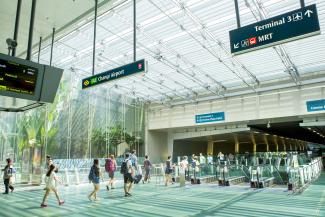
Singapore, 29 September 2020 (Tuesday) – The Institute of Service Excellence (ISE) (卓越服务研究院)at Singapore Management University (SMU) today released the 2020 second quarter (Q2) Customer Satisfaction Index of Singapore (CSISG) research findings for the Air Transport and Land Transport sectors.
Land Transport
In this year’s study, the Land Transport sector saw its two biggest constituent sub-sectors, the Mass Rapid Transit (MRT) System sub-sector and Public Buses sub-sector, registered substantial increases in their commuter satisfaction scores.
The MRT System sub-sector rose by 11.0% over a comparable 2019 study to score 73.4 points. Similarly, the Public Buses sub-sector saw an 8.1% rise to score 74.4 points. The Land Transport sector’s third constituent sub-sector was the Point-to-Point Transport sub-sector, which scored 75.9 points; there was no comparable year-on-year performance as this sub-sector was separately measured in previous years as taxis and transport booking apps.
“The COVID-19 Circuit Breaker period saw a reduced number of trips taken on the public transport network and provided our researchers with an opportunity for macro-level observations of commuter perceptions and satisfaction levels during and after the Circuit Breaker,” said Ms Neeta Lachmandas (妮塔.拉切曼达斯), Executive Director (执行总监) of ISE.
The study’s fieldwork period coincided with the Circuit Breaker period, where there were much fewer people taking both trains and buses, as well as the Phase One and Two reopening of the economy, where people gradually resumed commuting.
“The observations in commuter satisfaction between the periods was palpable. For instance, satisfaction with the MRT was 78.5 points at the start of the study’s fieldwork, which was during the Circuit Breaker period. Towards the end of fieldwork, and several weeks into the Phase Two reopening, satisfaction levels fell as low as 70.2 points,” she remarked.
Indeed, all 16 MRT System specific attributes saw statistically significant improvements over 2019 during the Circuit Breaker period, only to swing back downwards post-Circuit Breaker; similar swings in attribute ratings were observed in the Public Buses sub-sector. These attributes measured commuters’ perceptions in areas such as frequency, cleanliness, and safety.
Air Transport
The Air Transport sector, comprising of the Airport, Budget Airlines, and Full-Service Airlines sub-sectors, was also measured during the same period; they scored 81.7 points, 73.9 points, and 77.0 points, respectively. Only locals who had travelled overseas by air in the past 6 months were interviewed; most of them would have flown earlier in the year, prior to the start of travel restrictions. Due to the absence of available tourists for interviews, as well as the change in the study’s survey methodologies, from face-to-face to online interviews, these results were not comparable with the 2019 scores.
Notwithstanding these changes, analysis of the 2020 dataset for the airlines revealed that brand-related attributes were among the key drivers of customer loyalty. This was true for both full-service airlines as well as the budget carriers.
For instance, the brand-related attribute ‘Brand image complements lifestyle’ was a more important lever of loyalty than other more intuitive flight experience related attributes, such as having a friendly and attentive cabin crew or a comfortable journey.
Mr Chen Yongchang (陈勇畅), Head of Research and Consulting at ISE, said, “While passenger volumes are currently at record lows, such analysis can help shed insights into the types of strategies to employ when air travel demand picks up again.”
“By focusing on key drivers of loyalty, be it the comfort of journey or developing a brand image that resonates, airlines that can most effectively address them in their value propositions will be best positioned for the future,” he added.
Public Perception of COVID-19 Measures
The CSISG Q2 study also examined survey respondents’ perceptions of the air and land transport operators’ efforts to keep customers safe from COVID-19 infections. Respondents gave Changi Airport the highest rating at 8.08 points on a 1 to 10 scale, while train operators got the lowest rating, at 7.06 points.
Commented Mr Chen, “Interestingly for the public transport operators, the increase in commuter travel volumes and easing of some safe-distancing restrictions post-Circuit Breaker were associated with a negative impact on commuters’ perceptions of operators’ COVID-19 safety efforts. This was observed alongside negative impacts on commuters’ trust in the Operator.”
“Commuters responding to the survey have suggested an increase to train and bus frequencies to allow for more safe distancing. As there is a practical limit to how much further headway can be reduced and frequencies increased, Public Transport Operators should continue to reassure and demonstrate to commuters of their commitment to passenger safety, particularly amid these uncertain times,” he noted.
The CSISG 2020 Q2 study was conducted between April and July 2020. A total of 7,448 respondents were surveyed through online interviews.
Please refer to Annex A for a background on the CSISG and Annex B for the detailed scores.